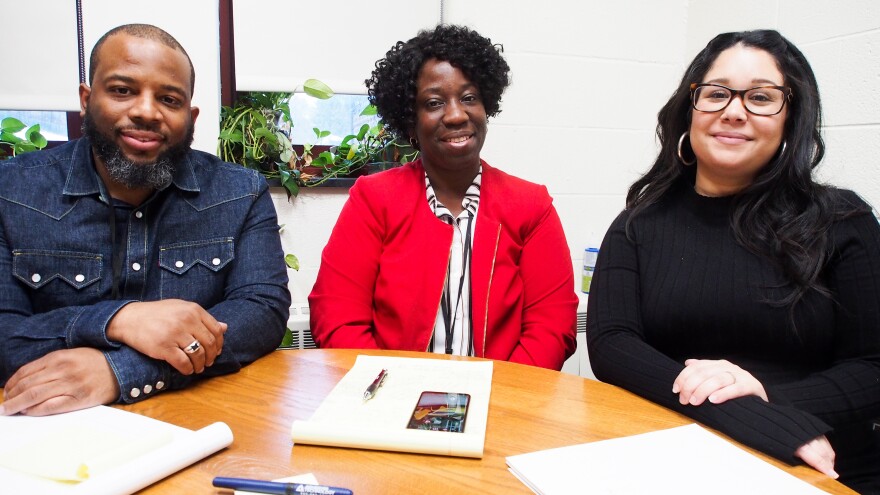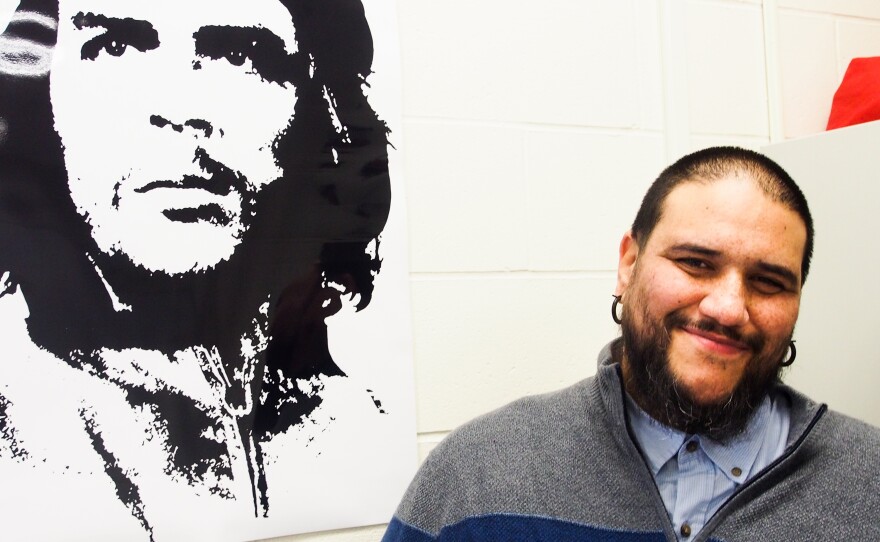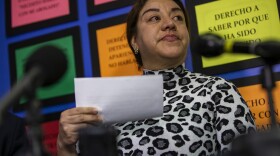Public schools in Massachusetts are closed for at least the next two weeks, very likely longer. But when they do reopen, one persistent problem will remain: a shortage of teachers and administrators of color.
Covered in tattoos, wearing shorts in December, special education teacher Norman Pacheco said he doesn’t fit the typical teacher stereotype.
“I'm half Chicano and half Native American,” Pacheco said. “I'm a nice caramel-brown. So, you know, I definitely stick out in a building.”
This is Pacheco’s first year at Holyoke STEM Academy, following several years at JFK Middle School in Northampton, Massachusetts. In both jobs, he said he’s been one of just a handful of teachers of color.
That’s a common occurrence in schools across western Massachusetts, even while students in these schools are increasingly likely to be Latino, black or Asian American.
“In my three years of Holyoke High, I've only had a single teacher of color,” said Salome Moreno, a junior. “And that was my sophomore year. She taught ethnic studies, and she lasted less than a month.”
Holyoke schools are now 86% students of color, the vast majority Latino.
Amherst schools are 48% students of color, and Northampton schools are 29%.
But the percentage of teachers and administrators of color in these districts has remained far below that of students.
Holyoke’s professional teacher workforce is 23%. Amherst’s is 22%. Northampton’s is only 6%.
According to Pacheco, that’s a huge problem.
“We need more teachers of color,” he said. “We need more administrators of color. We need kids of color to see that there is a future beyond the ends of their noses.”
In an influential study from 2018, researchers at Johns Hopkins University found that black students who had a black teacher by third grade were 13% more likely to enroll in college. Black students with two black teachers were 32% more likely to go to college.
Educators call this the role-model effect, and while fewer studies have been done with Latino or other students of color, Amherst Regional High School senior Pierre Tilus — who’s African American and part of a multi-racial peer leadership group at school — said it’s a pretty simple equation.
“I can say that it's easier to talk to somebody that looks like you,” Tilus said.

Senior Leakhena Chham also participates in the group. She said learning about her Cambodian culture from someone who’s not Cambodian can be alienating.
“When I've had people talk about my past religious life or the history of it, it was like, a fact,” Chham said. “But when somebody that looked like me talked to me about it, I understood it more, and felt more connected, and more part of it.”
At Holyoke High, some Latino students say they feel disconnected from their teachers and from many of their white peers.
Junior Salome Moreno said some white students have parents who are teachers or administrators at the school, but the relatives of her Latino friends are much more likely to work as cafeteria staff.
“Or they work in the main office, typing,” said Zaiell Vargas, a senior.
“Yeah, my friend's aunt is a lunch lady as well,” said sophomore Juan Morales.
Vargas said this sort of reflection matters tremendously.
“You're never going to be what you want to be, because it's not represented here, so you're not gonna believe it,” Vargas said.
I asked administrators in Holyoke, Amherst and Northampton to identify the biggest challenge they face in diversifying their teacher workforces.
“It’s definitely the pipeline,” said John Provost, superintendent of Northampton Schools.
The teacher pipeline: the term is shorthand for the cultural, institutional and economic factors that support — or often deter — potential teachers.
Kelly Curran, manager of recruitment for Holyoke schools, described one of the frequent manifestations of the pipeline.
“When I go to hiring fairs, just the people who come are mostly white women that want to teach elementary,” Curran said. “And there’s a few history teachers.”
The fact is, education is dominated by white people. The Massachusetts teacher workforce is currently 90% white, and there are numerous points along the teacher pipeline where candidates of color are winnowed out.
One of the biggest dropoffs occurs during testing, with fewer students of color passing the educator licensure exams.
Massachusetts education Commissioner Jeffrey Riley now proposes allowing candidates with repeat test failures to receive their licenses based on a review of their actual teaching skills. He calls it an “alternative pathway.” The Massachusetts Board of Elementary and Secondary Education will vote on the proposal in April.
However it’s accomplished, Damany Gordon has been waiting for decades to see more teachers of color in Amherst schools. He graduated from Amherst High in 1997.
“Ever since I was a kid in school, it's been talked about — diversifying the staff in Amherst — and it didn't really happen too much,” Gordon said.

Gordon is now the diversity and equity specialist at Amherst schools. He said the pipeline issues are real, but they shouldn’t be used as excuses for failing to hire educators of color.
“It's hard to find teachers of color. It's hard to find admins of color,” Gordon said. “But you have to do the work behind that. You have to go out and recruit, and create systems that are institutionalized.”
Doreen Cunningham, assistant superintendent at Amherst Schools, agreed.
“We make the personal phone calls,” Cunningham said. “We call people, and we say, ‘Amherst has this position available. We see that you have these qualifications that may fit. If you're interested, please apply.’”
Amherst isn’t the only district to change up its hiring practices in recent years. Northampton and Holyoke now require diverse representation on all search committees. Holyoke recruits teachers directly from Puerto Rico — and like Amherst, they’ve added a full-time equity position on staff.
Northampton created a part-time equity position last year, but it was put on indefinite hold during contract negotiations over the summer. Holyoke and Amherst districts also received grants two years in a row from the District Teacher Diversification Pilot Program.
Teachers of color have gone up almost 10% in Holyoke in the last three years, while Northampton’s numbers have remained static.
Amherst’s increase in the same time period is 5%, but the district has made substantive changes to almost every phase of recruitment, hiring and teacher support.
Jennifer Ortiz is an administrator of human resources for Amherst schools.
“I think that the biggest change is we have now two different committees when we're hiring for one position,” Ortiz said.
One group screens the candidates to make sure they’re qualified, Ortiz said. Another group then conducts the interviews, with no prior information about the candidates.
“We tried to make the process as blind as possible to limit the bias,” she said.
In the end, the biggest change the Amherst district has made to recruitment and hiring is that their human resources department is their diversity and equity department, and it’s run entirely by Cunningham, Gordon and Ortiz — three black and Latino administrators.
This year, almost half their new professional hires were people of color.
“I've been here two, going on three, years right now,” Cunningham said. “And we had never walked into a room where 43% of the people in that room were people of color.”
Amherst’s progress is measurable, but change isn’t coming fast enough for some students.
Senior Jaydon Perez is a Hispanic student at Amherst High. He said the district might be trying to meet quotas for new staff of color, but this hasn’t had a significant effect on academics.
“There hasn't been any new people of color, male or female teachers, getting added into any of our core classes, which is really the big thing that affects if we pass high school or not,” Perez said.
Perez’s comments point to one of the biggest challenges of working on equity in education: While administrators, academics, and lawmakers try to enact lasting changes to practice and policy, there are students, at this moment, experiencing the real impacts of systemic bias and long-term disenfranchisement.
This is part one of a series. Here is part two and part three.
Correction: An earlier version of this web story included an incorrect number for students of color in Northampton. The correct number is 29%.









